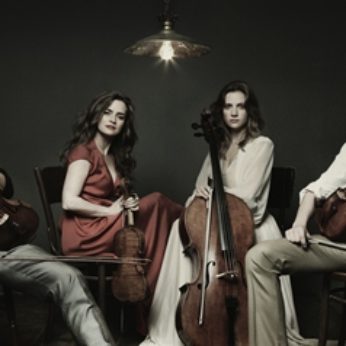Composer: György Ligeti (b. 1923 - d. 2006)
Performance date: 28/06/2013
Venue: Bantry Library
Composition Year: 1953-5
Duration: 00:21:11
Recording Engineer: Damian Chennells, RTÉ lyric fm
Instrumentation: pf
Instrumentation Category:String Quartet
Artists:
Kelemen Quartet (Barnabás Kelemen, Gábor Homoki [violins], Katalin Kokas [viola], Dóra Kokas [cello]) -
[quartet]

In
the sixties, Ligeti prohibited performances of this work along with
other works from his Hungarian period. He fled Hungary in 1956 and
considered these works too old-fashioned for the new
Darmstadt-Cologne influenced composer. The quartet was written in
1953-4 and was intended for his bottom drawer, as public performance
of such a work in the Hungary of that time was impossible. The
communist dictatorship was still in control and the only permitted
music was Socialist Realism, a cheap kind of art aimed at the masses
and designed to promote prescribed political propaganda. The internal
logic of this was so dislocated that although Bartók was the great
national hero-composer, most of his works were banned! The only
Bartók works that could be performed were his conciliatory,
non-dissonant works like the Concerto for Orchestra and the Third
Piano Concerto. So in Budapest there arose a culture of closed rooms
in which most non-conformist artists opted for inner emigration. The
first performance of this quartet eventually took place in Vienna in
1958.
Inspiration
came from studying the scores of Bartók’s third and fourth
quartets and Berg’s Lyric
Suite –
no chance of hearing such dissonant works performed in Hungary at
that time – and from the classical model of Beethoven’s Diabelli
Variations.
From Bartók come the chromatically intense melodic and harmonic
language and the textural contrasts, from Ligeti himself the
explosive and disruptive forces that threaten to tear the fabric
apart. Mind you the quartet was submitted for the Queen Elizabeth of
Belgium Competition in 1955 and was considered too conventional even
to be short-listed.
The
quartet is presented as a single movement of almost symphonic
dimensions, ostensibly in many different motivically linked sections,
that can also be seen as a four-movement structure. There is a
ternary exposition that opposes three contrasting presentations of
the germinal four-note motif, grazioso,
capriccioso and
mesto
in
Ligeti’s typically brutal manner before resolving them in an
exhilarating Presto. This accelerates to prestissimo from which
mysterious nocturnal tremolos emerge later accompanied by a warm
chordal chorale, Andante
tranquillo,
the equivalent of a slow movement, that fades to silence before the
Tempo di Valse. This functions like a scherzo before the
light-hearted rondo-style finale beginning with Allegretto,
un poco giovale. This
presents us with a kaleidoscope of special effects including a wild
Prestissimo. The final section presents the original four-note motif
like a cantus firmus over a whirring fabric of glissando harmonics.
Copyright © 2025 West Cork Music. All rights reserved.
Designed and developed by Matrix Internet